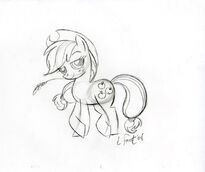Core Concepts
In this tutorial brought to you by the ChemTalk team, you will learn about chair conformations. More specifically, you will learn how to convert 2D cyclohexane structures into 3D chair conformations, determine the stability of the conformation, and complete a chair flip.
Covered in Other Articles
- Newman Projections
- Fischer Projections
- Naming Cycloalkanes
What are chair conformations?
Chair conformations are the most stable conformations cyclohexane can form. The basic structure is shown below. Each point represents carbon. To help visualize, it should be noted that carbon 1 is pointing up above the plane and carbon 4 is pointing down below the plane. Every other carbon lies in the same plane. Moreover, the conformation continuously jumps back and forth between its most stable forms. This swap is called the chair flip and it is explained further down this article!
Basic Structure

To draw a basic chair conformation, start by drawing two sets of parallel lines and connect them like seen above. After you have drawn the chair conformation, the next step is to number the carbons. The cool thing about this is that it doesn’t matter which way you number the carbons. This means you could go counterclockwise or clockwise. Along with the direction, it also does not matter where you start counting. One way to go about numbering is to place carbon number 1 on the top right point. Then, place carbon number 4 on the bottom left point. The most important thing here is that you should place the substituents on the same carbon they are connected to in the cyclohexane. This means if you have a methyl on carbon 4, you should place that same methyl group on the carbon labeled 4.
Axial and Equatorial Bonds

Carbon-carbon bonds that are a part of the cyclohexane are drawn as part of the chair’s basic structure. Apart from these are two types of bonds we use in chair conformations: axial and equatorial. These bonds attach to hydrogens, functional groups, and other substituents. In the figure above, axial bonds are positioned perpendicular (straight) to the structure and are shown in red. Meanwhile, equatorial bonds stand slanted and are shown in blue. When drawing chair conformations, the type of bond alternates. If carbon one is axial, then carbon two is equatorial.
Stability and Ring Flips
Some chair conformations are more stable than the others and therefore preferred. A key factor for determining stability is to calculate the 1,3-diaxial strain. This is a type of steric interaction that occurs when bulky attachments are located on axial bonds. To calculate the 1,3-diaxial strain, you must add the strain energies of substituents located on the axial bonds. You can find strain energies for a variety of different substituents in the table below.

As previously stated, we prefer larger substituents to be located on equatorial bonds. This reduces strain energy. In order to rotate the substituents onto different bonds, we must complete a ring flip. Ring flips are easy and involve 3 main steps:

- Draw another chair structure but in reverse.
- Shift the numbering clockwise by one.
- Write the substituents in their new spots. Calculate the ring strain and compare it to the first chair.






